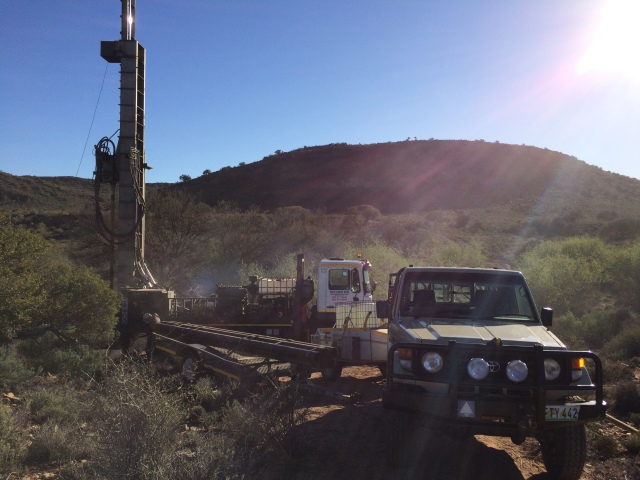The deep earth-shaking rumble sounded like an old World War II Sherman tank coming, but it was the massive borehole drilling rig, maneuvering the narrow, bumpy dirt road on its double-wide tires with the agility of a Klipspringer. Tagging behind it was a truck carrying a huge generator to power the drill, towing several hundred gallons of diesel fuel. Last in the procession was the bakkie (pick-up truck) of Don, the foremost and friendliest borehole expert of the greater Ladismith region.  The team managed to pull the drilling-end of the rig to exactly the “X” carved into the soft sandy soil by the dowser days before, and within an hour, the drilling began. Fresh water pumped from this well would be essential to attracting wildlife to the region, and keeping them healthy while they are here. But would we even hit the underground water promised by the dowser?
The team managed to pull the drilling-end of the rig to exactly the “X” carved into the soft sandy soil by the dowser days before, and within an hour, the drilling began. Fresh water pumped from this well would be essential to attracting wildlife to the region, and keeping them healthy while they are here. But would we even hit the underground water promised by the dowser?
The “drill” was actually a series of bits in long (4-meter) steel pipes that would be fitted together and lowered to grind straight through the earth. As the first segment drills its way down, it is pulled up and an extension added, and when that drills to its maximum depth, it is pulled back up and a third unit added and so forth, until the aquifer was ultimately reached, or until Don runs out of drilling segments. Fresh water, brought in on yet another truck, cooled and lubricated friction on the drill as it ground its way through the unseen bedrock below. Don would take sediment samples every 10 meters or so, examining the grit for geological cues to the water-holding rocks in the aquifer deep

Drill Baby, Drill!
underground. Drilling was a slow, loud, smoky, dusty, and tedious spectator’s event, but with every section added to the drill, there was the dream of a Hollywood-style eruption of glorious fresh water high into the blue Klein Karoo sky.
That was not to be.
Drilling lasted for the entire day until the boring unit used up all of its drilling segments, and ran out of both diesel and water. Returning fresh the next morning with renewed hope and more drilling sections for an even deeper borehole, hope was renewed.
That hope too, was not to last long.
Three days of drilling exhausted all of the extra sections of drill bits and pipe, so many pieces end-to-end that no more could be added because the torque from the long stem of connected segments would have damaged the unit rather than burrow deeper into the bedrock. One hundred and fifty-seven meters in all – over 500 feet – as deep into the ground as a 47-story building is high. After the team packed up their rig, I asked one of the drilling operators, a tall man with thick, leather-like skin from a life under the sun of this semi-desert, if there was any water. Not saying a word, he pulled out a piece of broken mirror from his truck and handed it to me. It took me a few seconds to realize I could reflect the sun into the new puncture in the earth, and I saw the image of the sun sink hundreds of feet into the oblivion below, with no sparkles of water at the bottom. Don didn’t find any promising sediments pulled up in the last few samples, and in a friendly but matter-of-fact tone tried to console me by telling similar hard-luck stories of previous clients ending up with expensive dust-holes. Nothing about digging a borehole is any promise or guarantee of water, and such follies can be chalked up to the many heartbreaks of trying to control nature. Was the dowser wrong? Would the hole ever be a viable well? Money lost, lessons learned, and a plan B for water began. But, as I would later learn, a surprising bit of luck was on our side.

